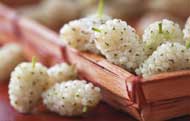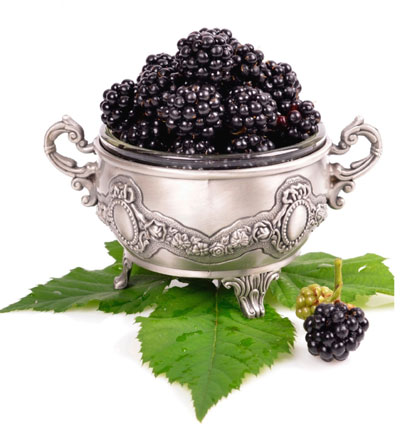





1. Mulberry Facts
2. Types of Mulberries
3. Nutritional Value of Mulberries
4. Health Benefits of Mulberries
Morus, a genus of flowering plants in the family Moraceae, consists of 19 species of deciduous trees commonly known as mulberries, growing wild and under cultivation in many temperate world regions. Generally, the genus has 64 subordinate taxa, though the three most common are referred to as white, red, and black, originating from the colour of their dormant buds and not necessarily the fruit colour (Morus alba, M. rubra, and M. nigra, respectively), with numerous cultivars and some taxa currently unchecked and awaiting taxonomic scrutiny. M. alba is native to South Asia, but is widely distributed across Europe, Southern Africa, South America, and North America. M. alba is also the species most preferred by the silkworm. It is regarded as an invasive species in Brazil, the United States and some states of Australia.
The closely related genus Broussonetia is also commonly known as mulberry, notably the paper mulberry (Broussonetia papyrifera).
Mulberries are fast-growing when young and can grow to 24 metres (79 feet) tall. The leaves are alternately arranged, simple, and often lobed and serrated on the margin. Lobes are more common on juvenile shoots than on mature trees. The trees can be monoecious or dioecious.
The mulberry fruit is a multiple, about 2–3 centimetres (3⁄4–1+1⁄4 inches) long. Immature fruits are white, green, or pale yellow. The fruit turns from pink to red while ripening, then dark purple or black, and has a sweet flavour when fully ripe.
History and Origin
Mulberries originated in temperate Asia, specifically China, where their cultivation for silkworms began over 4,700 years ago. Over centuries, they were introduced to Europe by the Greeks and Romans, then spread to Latin America, Africa, and North America. Today, mulberries have a very wide global distribution, being grown in temperate and tropical regions across Asia, Europe, Africa, and the Americas, both for silkworm food and fruit production.
- • Black Mulberry
- • Black Seedling
- • Pakistan
- • Vratza 24
- • White Mulberry
- • Red Mulberry
- • Hicks Fancy
- • Dwarf varieties
- • Shahtoot
- • Native Mulberry (Hedycarya angustifolia)
- • Native Mulberry (Pipurus argenteus)
Commonly grown and sold mulberries in Australia include white (Morus alba), red, and black (Morus nigra) types, which are imported species. In addition to these, Australian nurseries also sell specific cultivars like "Black Seedling," "Hicks Fancy," and Pakistan, along with dwarf varieties and less common types like "Shahtoot" and "Vratza 24". Australia also has native mulberries like Hedycarya angustifolia and Pipurus argenteus, though they belong to different plant families and are not as commercially common.
Imported varieties
Black Mulberry: A common garden Favorite, with very sweet, dark berries.
Black Seedling: A seed-grown variety, it is a vigorous grower with sweet, juicy berries.
Pakistan: A specific cultivar with long, sweet fruit.
Vratza 24: A specific cultivar of the white mulberry, grown for its large fruit yield.
White Mulberry: Available in white varieties, often grown in backyards.
Red Mulberry: Another type commonly grown, though some sources note that black mulberry grows particularly well in tropical climates.
Specific cultivars
Hicks Fancy: A self-pollinating variety that produces juicy, sweet fruit with a hint of tartness.
Dwarf varieties: Available in black and other types, these are suitable for smaller gardens.
Shahtoot: A less common but available variety.
Native species
Native Mulberry (Hedycarya angustifolia): A type of Australian native mulberry.
Native Mulberry (Pipurus argenteus): Also known as Native Mulberry, it belongs to a different family from the common imported species.
Fruit ” Mulberry ” ( Nutritional value )
Nutritional value per 100 g
Mulberries, raw
|
Nutrient ( Proximate’s )
|
Unit
|
Value
|
Daily Value %
|
|
Energy
|
kcal
|
43
|
2.1%
|
|
Protein
|
g
|
1.44
|
2.8%
|
|
Total lipid (fat)
|
g
|
0.39
|
0.5%
|
|
Carbohydrate, by difference
|
g
|
9.80
|
3.5%
|
|
Fiber, total dietary
|
g
|
1.7
|
6.0%
|
|
Sugars, total
|
g
|
8.10
|
|
|
Minerals
|
|||
|
Calcium, Ca
|
mg
|
39
|
3%
|
|
Iron, Fe
|
mg
|
1.85
|
10.2%
|
|
Magnesium, Mg
|
mg
|
18
|
4.2%
|
|
Phosphorus, P
|
mg
|
38
|
3.0%
|
|
Potassium, K
|
mg
|
194
|
4.1%
|
|
Sodium, Na
|
mg
|
10
|
0.4%
|
|
Zinc, Zn
|
mg
|
0.12
|
1.0%
|
|
Copper, Cu
|
mg
|
0.060
|
6.6%
|
|
Selenium, Se
|
mcg
|
0.6
|
1.0%
|
|
Vitamins
|
|||
|
Vitamin C, total ascorbic acid
|
mg
|
36.4
|
40.4%
|
|
Thiamin (B-1)
|
mg
|
0.029
|
2.4%
|
|
Riboflavin (B-2)
|
mg
|
0.101
|
7.7%
|
|
Niacin (B-3)
|
mg
|
0.620
|
3.8%
|
|
Vitamin B-6
|
mg
|
0.050
|
2.9%
|
|
Vitamin B-12
|
mg
|
0.00
|
|
|
Folate DFE (dietary folate) (B-9)
|
mcg
|
6
|
1.5%
|
|
Vitamin A, RAE (retinol)
|
mcg
|
||
|
Vitamin E (alpha-tocopherol)
|
mg
|
0.87
|
5.8%
|
|
Vitamin D (D2 + D3)
|
mcg
|
0
|
|
|
Vitamin K (phylloquinone)
|
mcg
|
7.8
|
6.5%
|
|
Lipids
|
|||
|
Saturated Fatty Acids
|
g
|
0.027
|
0.1%
|
|
Monounsaturated Fatty Acids
|
g
|
0.041
|
|
|
Polyunsaturated Fatty Acids
|
g
|
0.207
|
|
|
Trans Fatty Acids
|
g
|
0.000
|
|
|
Carotenoids
|
|||
|
Beta-Carotene
|
mcg
|
9
|
|
|
Alpha-Carotene
|
mcg
|
12
|
|
|
Lutein + zeaxanthin
|
mcg
|
136
|
|

|
Reference Values are based on a 2,000 Calorie Intake, for Adults and Children 4 or More Years of Age. Your daily values may be higher or lower depending on your calorie needs.
|
|
Percentages are roughly approximated using (RDA) Recommended Dietary Allowances for adults. Source: Nutrient Database – USDA (United States Department of Agriculture)
|
|
Reference Values for Nutrition – FDA U.S. Food and Drug Administration
|
Mulberry Nutritional Value
Mulberries are rich in antioxidants, vitamins, and minerals that offer various health benefits, including supporting heart and digestive health, boosting immunity, and helping with blood sugar and cholesterol management. They are a good source of iron, vitamin C, and fiber, and contain compounds that may help prevent chronic diseases like cancer and protect eye health.
- HEART HEALTH
Mulberries support heart health by helping to lower cholesterol and blood pressure, reduce inflammation, and prevent the buildup of plaque in arteries (atherosclerosis). Compounds in mulberry leaves and fruit, such as flavonoids, may improve the ratio of "good" (HDL) to "bad" (LDL) cholesterol and reduce oxidative stress. - IMMUNE SUPPORT
Mulberries support the immune system due to their high content of vitamin C and antioxidants, which protect against cellular damage and strengthen the body's natural defences. Additionally, compounds like mulberry polysaccharides have demonstrated the ability to modulate immune responses by activating immune cells and may even have anti-inflammatory effects. - ANTI-AGING AND COGNITIVE FUNCTION
Mulberries show promise for anti-aging and cognitive function, primarily due to their high content of antioxidants like polyphenols and anthocyanins. Studies in animal models suggest that mulberry extracts can protect against age-related cognitive decline and memory impairment by combating oxidative stress and potentially enhancing cholinergic function and hippocampal morphology. Human studies, though limited, have also shown potential cognitive benefits from black mulberry consumption. - IMPORTANT CONSIDERATIONS
When eating mulberries, be aware of potential interactions with diabetes and blood-thinning medications, a risk of low blood sugar, and digestive issues from overconsumption. People with certain allergies, especially those with birch pollen sensitivity, should be cautious.

- EYE HEALTH
Mulberries benefit eye health due to their antioxidant properties, which protect against age-related conditions like macular degeneration and cataracts. They contain compounds like zeaxanthin, vitamin C, and flavonoids that help reduce oxidative stress and protect against free radical damage to the retina. The high vitamin A content is also beneficial for maintaining good vision and can help relieve eye strain. - BLOOD SUGAR MANAGEMENT
Mulberries may help manage blood sugar by slowing the absorption of sugar into the bloodstream, thanks to compounds like iminosugars that inhibit the enzymes that break down carbs. They also contain flavonoids and polyphenols, which can improve insulin sensitivity and reduce inflammation. While promising, most studies have been conducted on animals or mulberry leaf extracts, so more human research is needed before any firm conclusions can be drawn. - IRON SOURCE
Mulberries are a good source of iron, providing about 1.9 to 2.9 mg per cup, which can meet a significant portion of the daily requirement. This iron content is beneficial for the production of red blood cells, which are essential for transporting oxygen throughout the body. - DIGESTIVE HEALTH
Mulberries support digestive health by providing fiber that aids in regular bowel movements, prevents constipation, and promotes a healthy gut microbiome by feeding beneficial bacteria. While beneficial, overconsuming them can lead to digestive issues like gas and bloating, especially for those with sensitive stomachs.
References
Nutrient Database – USDA (United States Department of Agriculture)
Reference Values for Nutrition – FDA U.S. Food and Drug Administration
Heart health - Mulberries support heart health by helping to lower cholesterol and blood pressure, reduce inflammation, and prevent the buildup of plaque in arteries (atherosclerosis). Compounds in mulberry leaves and fruit, such as flavonoids, may improve the ratio of "good" (HDL) to "bad" (LDL) cholesterol and reduce oxidative stress.
Digestive health - Mulberries support digestive health by providing fiber that aids in regular bowel movements, prevents constipation, and promotes a healthy gut microbiome by feeding beneficial bacteria. While beneficial, overconsuming them can lead to digestive issues like gas and bloating, especially for those with sensitive stomachs.
Blood sugar management - Mulberries may help manage blood sugar by slowing the absorption of sugar into the bloodstream, thanks to compounds like iminosugars that inhibit the enzymes that break down carbs. They also contain flavonoids and polyphenols, which can improve insulin sensitivity and reduce inflammation. While promising, most studies have been conducted on animals or mulberry leaf extracts, so more human research is needed before any firm conclusions can be drawn.
Immune support - Mulberries support the immune system due to their high content of vitamin C and antioxidants, which protect against cellular damage and strengthen the body's natural defences. Additionally, compounds like mulberry polysaccharides have demonstrated the ability to modulate immune responses by activating immune cells and may even have anti-inflammatory effects.
Eye health - Mulberries benefit eye health due to their antioxidant properties, which protect against age-related conditions like macular degeneration and cataracts. They contain compounds like zeaxanthin, vitamin C, and flavonoids that help reduce oxidative stress and protect against free radical damage to the retina. The high vitamin A content is also beneficial for maintaining good vision and can help relieve eye strain.
Iron source - Mulberries are a good source of iron, providing about 1.9 to 2.9 mg per cup, which can meet a significant portion of the daily requirement. This iron content is beneficial for the production of red blood cells, which are essential for transporting oxygen throughout the body.
Anti-aging and cognitive function - Mulberries show promise for anti-aging and cognitive function, primarily due to their high content of antioxidants like polyphenols and anthocyanins. Studies in animal models suggest that mulberry extracts can protect against age-related cognitive decline and memory impairment by combating oxidative stress and potentially enhancing cholinergic function and hippocampal morphology. Human studies, though limited, have also shown potential cognitive benefits from black mulberry consumption.
Important considerations - When eating mulberries, be aware of potential interactions with diabetes and blood-thinning medications, a risk of low blood sugar, and digestive issues from overconsumption. People with certain allergies, especially those with birch pollen sensitivity, should be cautious, and those with kidney disease should consult a doctor due to their high potassium content. It is also advisable to eat them in moderation and watch for stains on teeth and hands.
